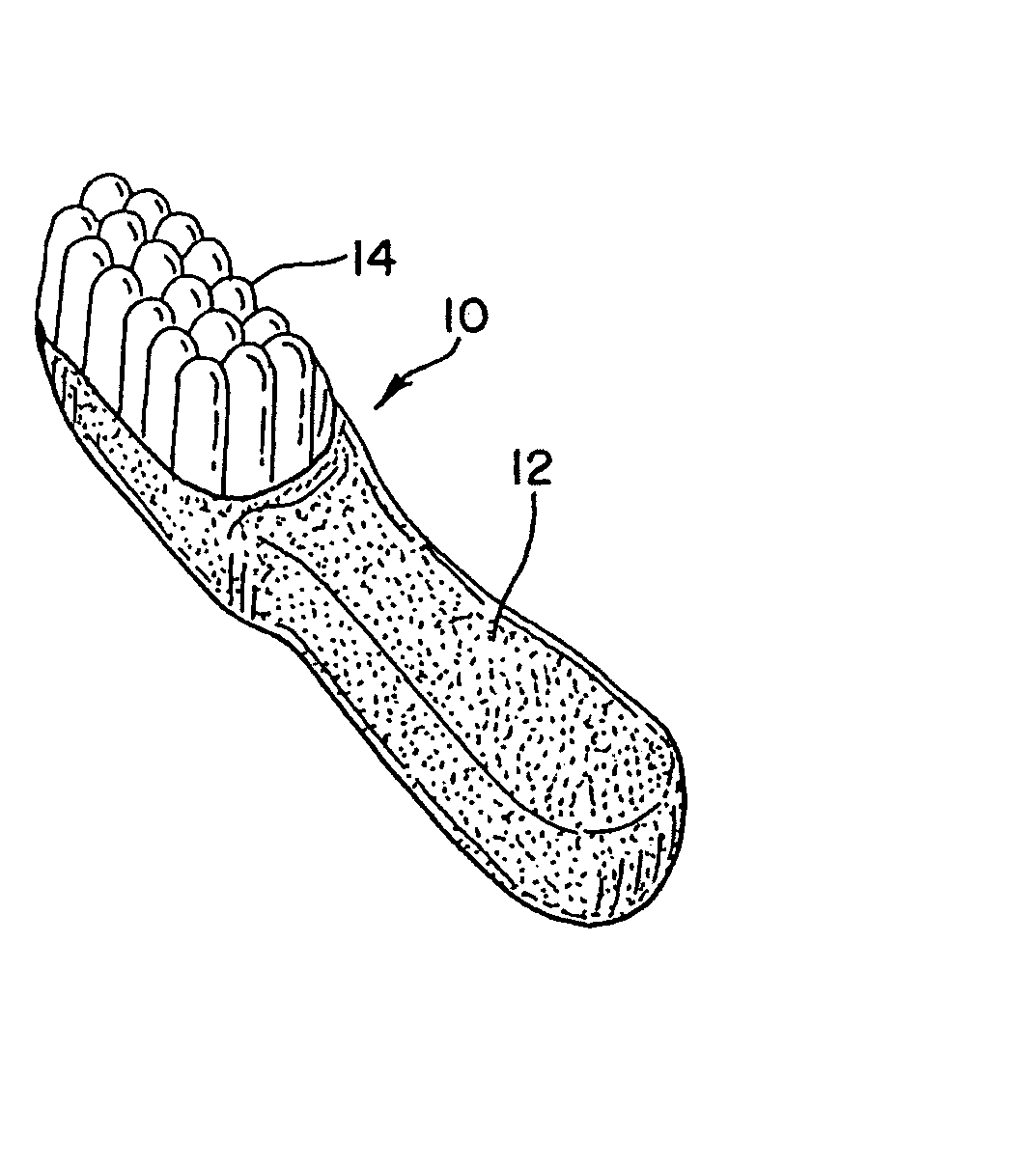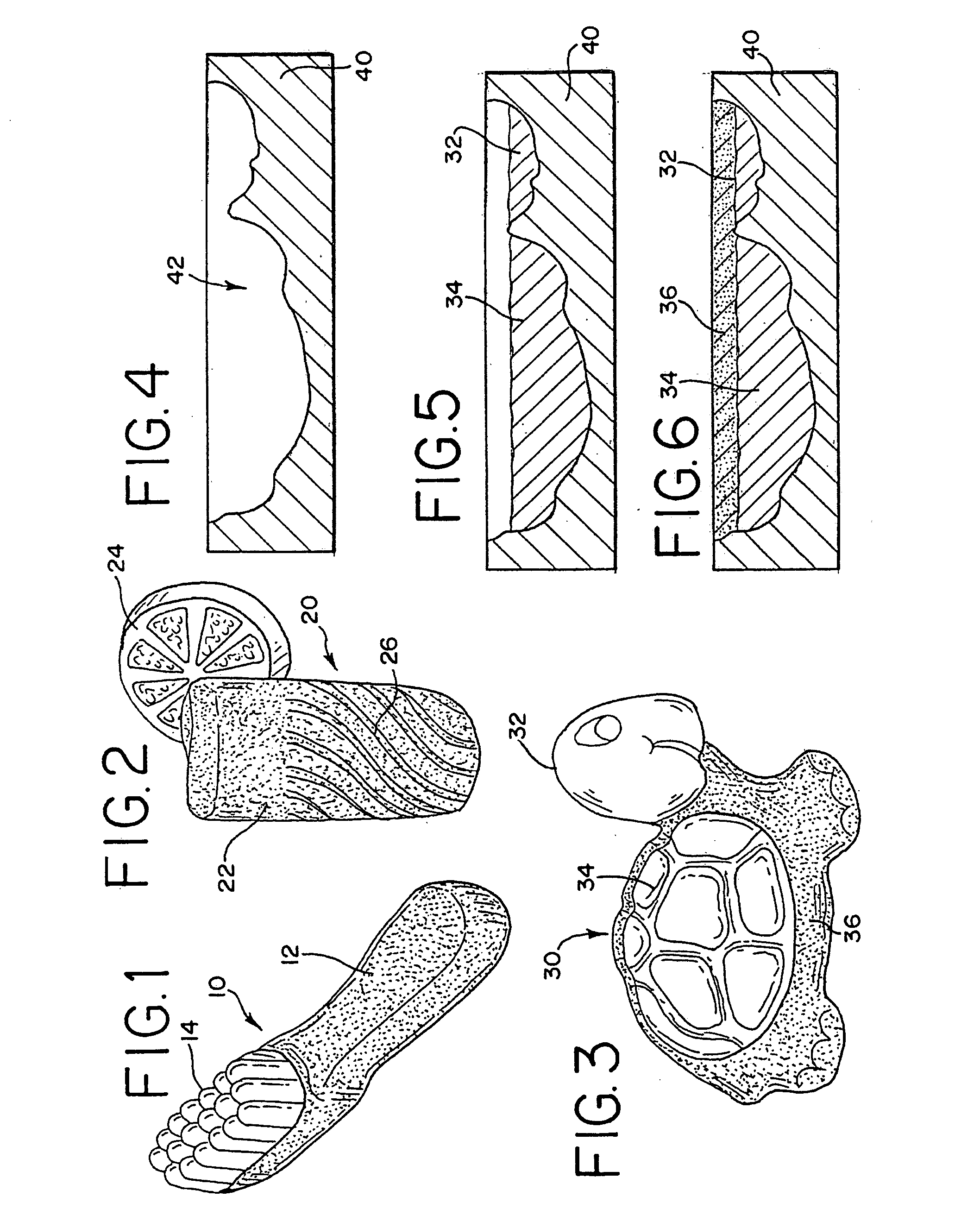Shaped chewing gum products containing soluble protein and methods of making same
a chewing gum and soluble protein technology, applied in chewing gum, packaging, confectionery, etc., can solve the problems of not being able to easily remove the product from the mold without affecting the shape, not being able to achieve the effect of soft typical textural properties
- Summary
- Abstract
- Description
- Claims
- Application Information
AI Technical Summary
Benefits of technology
Problems solved by technology
Method used
Image
Examples
example 2
Co-Deposited Chewing Gum and Taffy
[0046] A co-deposited product is made with the fluid gum of Example 1 and a taffy-type confectionery made as follows:
Ingredients%First CompositionSugar42.00Corn Syrup - 42 D.E.35.00Water10.00Sodium Citrate0.10Maltodextrin - 18 D.E.0.70Lecithin0.30Color0.05Gelatin MixtureGelatin - 150 Bloom1.00Water2.00Powdered Citric Acid1.00Fondant Sugar1.10Vegetable Fat6.50Flavor0.25TOTAL100.00
[0047] First, the gelatin is dissolved in water. Next the first seven ingredients are cooked to 225° F. (107° C.) to form the first composition (cooked candy). The gelatin / water is added to the cooked candy and this mixture is whipped or pulled to incorporate air. Finally the powdered citric acid, fondant sugar, vegetable oil and flavor are added after the whipping step. The total product is then loaded into a feeding hopper for co-depositing hot with the fluid gum composition. For a softer taffy part of the product, the cook temperature of the cooked candy can be reduced...
example 3
Co-Deposited Chewing Gum and Cooked / Hard Candy
[0048] A co-deposited cooked / hard candy product is made with the fluid gum of Example 1 and a cooked / hard candy confectionery made as follows:
Ingredients%Sugar63.72Corn Syrup - 42 D.E.42.48Net Water loss−6.50Color and Flavor0.30TOTAL100.00
[0049] The sugar, corn syrup and enough water to dissolve the sugar are combined. This water, and some of the water in the corn syrup, evaporates during cooking to produce the net water loss. The material is cooked to a temperature of 284-293° F. (140-145° C.). For a more glassy candy, try to prevent crystal growth by minimizing shear before loading into a feeder hopper for deposition with the fluid gum composition. For crystallized candy, increase the sugar content and reduce the amount of corn syrup. For a softer product, reduce the cook temperature.
example 4
Co-Deposited Chewing Gum and Caramel Candy
[0050] A co-deposited caramel candy product is made with the fluid gum of Example 1 and caramel candy confectionery made as follows:
Ingredients%Butter or Margarine20.68Brown Sugar46.53Light Cream41.36Corn Syrup - 42 D.E.20.03Net Water loss−29.10Color and Flavor0.50TOTAL100.00
Melt butter or margarine, add the rest of the ingredients, and cook to a temperature of about 255-260° F. (124-127° C.). The water loss comes from the butter or margarine, light cream and corn syrup. Transfer the product to the feeder hopper in the depositor. For a softer product, reduce the cook temperature.
PUM
 Login to View More
Login to View More Abstract
Description
Claims
Application Information
 Login to View More
Login to View More - R&D
- Intellectual Property
- Life Sciences
- Materials
- Tech Scout
- Unparalleled Data Quality
- Higher Quality Content
- 60% Fewer Hallucinations
Browse by: Latest US Patents, China's latest patents, Technical Efficacy Thesaurus, Application Domain, Technology Topic, Popular Technical Reports.
© 2025 PatSnap. All rights reserved.Legal|Privacy policy|Modern Slavery Act Transparency Statement|Sitemap|About US| Contact US: help@patsnap.com


